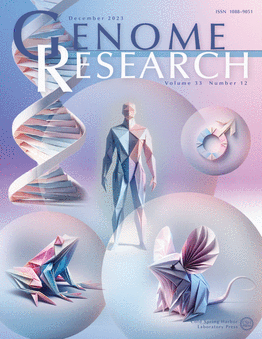Integrating genetic variation with deep learning provides context for variants impacting transcription factor binding during embryogenesis
IF 6.2
2区 生物学
Q1 BIOCHEMISTRY & MOLECULAR BIOLOGY
引用次数: 0
Abstract
Understanding how genetic variation impacts transcription factor (TF) binding remains a major challenge, limiting our ability to model disease-associated variants. Here, we used a highly controlled system of F1 crosses with extensive genetic diversity to profile allele-specific binding of four TFs at several time points during Drosophila embryogenesis. Using a combined haplotype test, we identified 9%–18% of TF-bound regions impacted by genetic variation even for essential regulators. By expanding WASP (a tool for allele-specific read mapping) to examine indels, we increased detection of allelically imbalanced peaks by 30%–50%. This fine-grained “mutagenesis” can reconstruct functionalized binding motifs for all factors. To prioritize causal variants, we trained a convolutional neural network (Basenji) to accurately predict binding from DNA sequence. The model can also predict measured allelic imbalance for strong effect variants, providing a mechanistic interpretation for how the variant impacts binding. This reveals unexpected relationships between TFs, including potential cooperative pairs, and mechanisms of tissue-specific recruitment of the ubiquitous factor CTCF.整合遗传变异与深度学习为胚胎发生过程中影响转录因子结合的变异提供了背景
了解遗传变异如何影响转录因子(TF)结合仍然是一个主要挑战,限制了我们建模疾病相关变异的能力。在这里,我们使用高度控制的具有广泛遗传多样性的F1杂交系统来分析果蝇胚胎发生过程中几个时间点上四个tf的等位基因特异性结合。使用组合单倍型测试,我们发现9%-18%的tf结合区域受到遗传变异的影响,即使是基本调节因子。通过扩展WASP(一种用于等位基因特异性读映射的工具)来检查索引,我们将等位基因不平衡峰的检测率提高了30%-50%。这种细粒度的“诱变”可以重建所有因子的功能化结合基序。为了优先考虑因果变异,我们训练了一个卷积神经网络(Basenji)来准确预测DNA序列的结合。该模型还可以预测强效应变异的测量等位基因失衡,为变异如何影响结合提供机制解释。这揭示了tf之间意想不到的关系,包括潜在的合作对,以及无处不在的CTCF因子的组织特异性募集机制。
本文章由计算机程序翻译,如有差异,请以英文原文为准。
求助全文
约1分钟内获得全文
求助全文
来源期刊

Genome research
生物-生化与分子生物学
CiteScore
12.40
自引率
1.40%
发文量
140
审稿时长
6 months
期刊介绍:
Launched in 1995, Genome Research is an international, continuously published, peer-reviewed journal that focuses on research that provides novel insights into the genome biology of all organisms, including advances in genomic medicine.
Among the topics considered by the journal are genome structure and function, comparative genomics, molecular evolution, genome-scale quantitative and population genetics, proteomics, epigenomics, and systems biology. The journal also features exciting gene discoveries and reports of cutting-edge computational biology and high-throughput methodologies.
New data in these areas are published as research papers, or methods and resource reports that provide novel information on technologies or tools that will be of interest to a broad readership. Complete data sets are presented electronically on the journal''s web site where appropriate. The journal also provides Reviews, Perspectives, and Insight/Outlook articles, which present commentary on the latest advances published both here and elsewhere, placing such progress in its broader biological context.
 求助内容:
求助内容: 应助结果提醒方式:
应助结果提醒方式:


